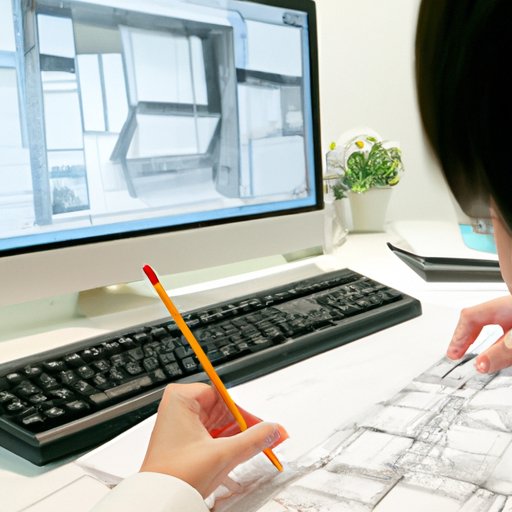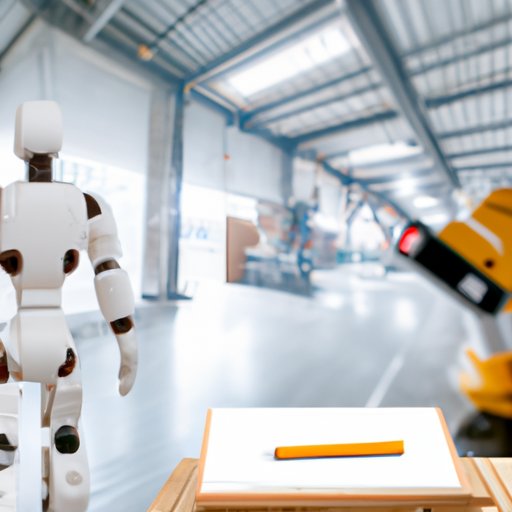Introduction
Computer science has become increasingly important in the field of architecture. The use of computer-aided design (CAD) software, big data, artificial intelligence (AI), virtual reality (VR), 3D printing, and robotics are all transforming the way architects approach their work. This article will explore how computer science is being used in architecture, looking at the various ways it is being employed and the potential benefits and challenges that come with its use.

Exploring the Use of Computer Aided Design in Architectural Projects
CAD is a computer-based tool used by architects to create, modify, analyze, and optimize designs. It allows for increased accuracy and efficiency when creating plans and drawings, allowing for faster and more precise modifications. According to a study published by Computers in Industry, “CAD technology is widely used in architecture and engineering design, and has been shown to improve accuracy and reduce design time.”
One of the main benefits of using CAD in architecture is that it allows for a greater level of detail in the design process. Architects can use the software to create detailed models of their projects, which can then be used to identify potential problems before construction begins. This helps to reduce the amount of time spent on reworking and revising designs, as well as reducing costs associated with mistakes.
CAD software can also be used to generate realistic renderings of a project, which can be used to help visualize the finished product. This can be particularly useful for clients who may not have a clear idea of what the end result will look like. Additionally, CAD can be used to create simulations of a building’s performance under certain conditions, such as wind or rain, which can help to ensure the structure is safe and stable.

Examining the Impact of Big Data and AI on Architectural Design
Big data is becoming an increasingly important tool for architects, allowing them to make better informed decisions based on large amounts of data. By analyzing data from previous projects, architects can gain insights into how different materials and methods perform in real-world applications. This can be used to inform future designs, helping to ensure the best possible outcome for each project.
AI is also beginning to be used in architectural design. AI algorithms can be used to automate certain tasks, such as generating 3D models from 2D drawings. AI can also be used to analyze data from past projects to identify patterns and trends, which can then be used to inform future designs. For example, an AI system can be trained to recognize the most successful designs and suggest similar solutions for new projects.
Analyzing the Benefits of Virtual Reality in Architectural Design
Virtual reality (VR) is becoming an increasingly popular tool for architects, allowing them to create immersive 3D environments that can be explored and interacted with. VR can be used to create realistic models of proposed buildings, giving clients a better understanding of what the finished product will look like. Additionally, VR can be used to simulate physical phenomena such as the flow of air or water, allowing architects to identify potential problems before construction begins.
VR can also be used to create interactive walkthroughs of a proposed building, allowing clients to explore the project from the comfort of their own home. This can be extremely useful for clients who may not have the opportunity to visit a site in person. Additionally, VR can be used to create training simulations for architects, allowing them to practice and refine their skills without risking costly mistakes.
Investigating the Role of 3D Printing in Architecture
3D printing is becoming an increasingly popular tool for architects, allowing them to quickly and cheaply produce 3D models of their designs. 3D printing works by depositing layers of material, such as plastic or metal, which are then fused together to create a solid object. This can be used to create detailed models of a proposed building, allowing architects to make changes and adjustments before construction begins.
3D printing can also be used to create custom components for a building, such as brackets or fixtures. This can help to reduce costs associated with ordering custom parts, as well as speeding up the construction process. Additionally, 3D printed components can be made to exact specifications, which can help to reduce the risk of structural failure.

Evaluating the Use of Robotics in Building Automation
Robotics is becoming an important tool for building automation, allowing architects to automate certain processes such as surveying or painting. Robotics can be used to create accurate 3D models of a proposed building, which can help to identify potential problems before construction begins. Additionally, robots can be used to automate certain tasks, such as painting walls or laying tiles, which can help to reduce labor costs and speed up the construction process.
Robots can also be used to monitor the progress of a project, allowing architects to track the progress of a building in real-time. This can help to identify any issues before they become too serious, as well as providing feedback on which areas need improvement. Additionally, robots can be used to detect changes in the environment, such as temperature or humidity, which can help to ensure the safety of a building.
Conclusion
Computer science is playing an increasingly important role in the field of architecture, allowing architects to create more detailed and accurate designs with greater efficiency. CAD, big data, AI, VR, 3D printing, and robotics are all being used to transform the way architects approach their work, offering a range of potential benefits and challenges. As technology continues to evolve, the use of computer science in architecture is likely to become even more commonplace, providing architects with powerful tools to help them create better buildings.
In summary, this article has explored the use of computer science in architecture, examining the benefits and challenges associated with CAD, big data, AI, virtual reality, 3D printing, and robotics as they relate to architectural design. Going forward, it is likely that these technologies will continue to play an important role in the field, allowing architects to create safer and more efficient buildings.
(Note: Is this article not meeting your expectations? Do you have knowledge or insights to share? Unlock new opportunities and expand your reach by joining our authors team. Click Registration to join us and share your expertise with our readers.)
